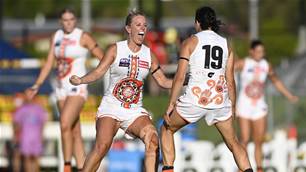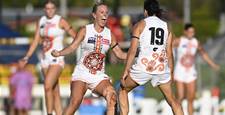The Footy Almanac have shared another extract from their latest publication in line with some of the recent commentary surrounding AFLW.
In the interest of avoiding further sleep disturbance, I have decided to stop listening to the more grating critics of women’s footy, because they are generally uninformed (and insist on staying that way) and seem to have a strange and murky underlying agenda which I haven’t quite figured out yet – and because I prefer to put my time and emotional energy to better use.
I don’t mean those people (including many men) who are genuinely critiquing and describing the women’s game with good intent and a desire to see the game improve and grow – there have been several recent media articles and commentary where I may have disagreed with a premise or a case, but where the discussion was genuine, informed, and accompanied by buckets of goodwill – which is fantastic and very welcome.
What the not-so-constructive detractors of women’s footy are missing (and are struggling to hear over the sound of their own diatribe) are the whys and wherefores of the emergence of AFLW, and why it has had such an extraordinary impact in so many ways. It's about these young people ‘doing and daring’ on game day – but it’s also important and valuable to know the context, the history, the striving and commitment that has made it happen, and the barriers that were knowingly erected to make it not happen for a painfully long time.
As a famed writer on play and sport said – “doing and daring are power, but knowing is magical power” (J Huizinga).
We should ‘know’, so as to do justice to those who together, and for decades, managed to continue to fashion their own holy grail out of whatever meagre resources they could muster – women are generally good at that. (My favourite story in Hess and Lenkic’s “Play On” is how a bunch of women in a country town years ago salvaged some PVC piping from the local plumber and turned it into a couple of wobbly goalposts that they could use at the local oval to practice shots at goal. Brilliant)
It’s a fascinating and enlightening story that has lessons and implications beyond football, and if we don’t have a little look at what happened, there is a risk that we will see it happening in other parts of our society, and for others with inspiring hopes and ambitions in their chosen field.
Having a constructive look at this may even benefit the children of the critics – they probably haven’t thought of that – if they have young daughters they should be delighted and relieved that there are such extraordinary characters visibly doing positive and courageous things with their lives, rather than sitting alone at home beholden to debilitating images on media screens of what the marketplace and culture designates as ‘femaleness’ or worthiness.
There are some wonderful generational lessons to be learnt, and I’m always grateful for any opportunity to be made aware of, better understand, and actively tackle, blind spots and barriers to the participation of any group in any activity or experience that is an assumed right for the rest of society.
As a person who lived through and participated actively in the ‘second feminist wave’ of the sixties and seventies, I’m now asking myself how it happened that I sat by naively and allowed the situation to perpetuate whereby half the population of this country weren’t allowed to play a particular sport.
Related Articles

Updated: AFLW Round 2 preview and schedule

Socceroo star's message to kids: Don't be an AFL player

.png&h=600&w=850&c=0&s=1)











